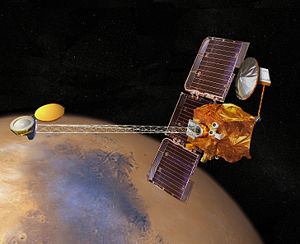2001 Mars Odyssey
 Conceptual drawing of 2001 Mars Odyssey over Mars |
|
| Organization | NASA |
|---|---|
| Mission type | Orbiter |
| Satellite of | Mars |
| Orbital insertion date | October 24, 2001 |
| Launch date | April 7, 2001 |
| Launch vehicle | Delta II |
| Home page | 2001 Mars Odyssey |
| Mass | 725 (331.8 + 348.7 fuel) kg |
| Power | 750W (Mars) |
| Orbital elements | |
| Semimajor axis | 3785 km (~400 km above surface) |
| Eccentricity | 0.0115 |
| Inclination | 93.2 deg |
| Orbital period | 1.964 hours |
2001 Mars Odyssey is a robotic spacecraft orbiting the planet Mars. Its mission is to use spectrometers and imagers to hunt for evidence of past or present water and volcanic activity on Mars. It is hoped that the data Odyssey obtains will help answer the question of whether life has ever existed on Mars. It also acts as a relay for communications between the Mars Explorations Rovers and Phoenix lander to Earth. The mission was named after the movie 2001: A Space Odyssey, and refers to the differences between the movie and real life by the year 2001.
Odyssey was launched April 7, 2001 on a Delta II rocket from Cape Canaveral Air Force Station and reached Mars on October 24, 2001, 0230 Universal Time (October 23, 7:30 p.m. PDT/ 10:30 EDT). The spacecraft's main engine fired to brake the spacecraft's speed and allowed it to be captured into orbit around Mars. Odyssey used a technique called "aerobraking" that gradually brought the spacecraft closer to Mars with each orbit. By using the atmosphere of Mars to slow down the spacecraft in its orbit rather than firing its engine or thrusters, Odyssey was able to save more than 200 kilograms (440 pounds) of propellant. Aerobraking ended in January, and Odyssey began its science mapping mission on February 19, 2002.
Contents |
Scientific instruments
The three primary instruments Odyssey uses are the:
- Thermal Emission Imaging System (THEMIS).[1]
- Gamma Ray Spectrometer (GRS),[2] which includes the High Energy Neutron Detector (HEND), provided by Russia.
- Mars Radiation Environment Experiment (MARIE).
On May 28, 2002, NASA reported that Odyssey's GRS had detected large amounts of hydrogen, a sign that there must be ice lying within a meter of the planet's surface.
Mission

NASA has approved a third two year extended mission through September 2010 to allow for the observation of year-to-year differences in phenomena like polar ice, clouds and dust storms as well as a much more sensitive mapping of martian minerals. On September 30, 2008 the spacecraft activated its thrusters for 6 min to begin altering the spacecrafts orbit to gain an even better sensitivity for its infrared mapping of Martian minerals. The change will cause the spacecraft to move from a late afternoon orbit to a mid afternoon orbit over time by decreasing the time it passed over a location by 20 second per day until a new thruster burn in late 2009 will solidify the orbit. Unfortunately, the new orbit will eliminate the use of one of the instruments the Gamma Ray Spectrometer Suite due to potential over heating of the instrument at the new orbit. The extension will also continue Odyssey's support for other Mars missions. The orbiter contains enough propellant to operate at least until 2015. About 85 percent of images and other data from NASA's twin Mars rovers, Spirit and Opportunity, have reached Earth via communications relay by Odyssey, which receives transmissions from both rovers every day. The orbiter helped analyze potential landing sites for the rovers and performed the same task for NASA's Phoenix mission, which landed on Mars in May, 2008. Odyssey aided NASA's Mars Reconnaissance Orbiter, which reached Mars in March 2006, by monitoring atmospheric conditions during months when the newly arrived orbiter used aerobraking to alter its orbit into the desired shape.

Water on Mars
On July 31, 2008, NASA announced that the Phoenix lander confirmed the presence of water on Mars,[3] as predicted on 2002 by the Odyssey orbiter. The science team is trying to determine whether the water ice ever thaws enough to be available for biology and if carbon-containing chemicals and other raw materials for life are present.
Naming
Mars Odyssey was originally named the Mars Surveyor 2001 Orbiter and was intended to have a companion spacecraft known as Mars Surveyor 2001 Lander. The lander mission was canceled in May 2000 following the failures of Mars Climate Orbiter and Mars Polar Lander in late 1999. Subsequently, the name 2001 Mars Odyssey was selected for the orbiter as a specific tribute to the vision of space exploration shown in works by Arthur C. Clarke, including 2001: A Space Odyssey. The music from Mythodea by Greek composer Vangelis was used as the theme music for the mission.
The project was developed by NASA, and contracted out to Lockheed Martin. The expected cost for the entire mission is US$297 million.
See also
- Exploration of Mars
- Nickel hydrogen battery
- Space exploration
- Image of 2001 Mars Odyssey Mission
References
- ↑ P. R. Christensen, B. M. Jakosky, H. H. Kieffer, M. C. Malin, H. Y. McSween Jr., K. Nealson, G. L. Mehall, S. H. Silverman, S. Ferry, M. Caplinger, M Ravine (2004). "The Thermal Emission Imaging System (THEMIS) for the Mars 2001 Odyssey Mission". Space Science Reviews 110 (1-2): 85. doi:.
- ↑ W.V. Boynton, W.C. Feldman, I.G. Mitrofanov, L.G. Evans, R.C. Reedy, S.W. Squyres, R. Starr, J.I. Trombka, C. d'Uston, J.R. Arnold, P.A.J. Englert, A.E. Metzger, H. Wänke, J. Brückner, D.M. Drake, C. Shinohara, C. Fellows, D.K. Hamara, K. Harshman, K. Kerry, C. Turner, M. Ward1, H. Barthe, K.R. Fuller, S.A. Storms, G.W. Thornton, J.L. Longmire, M.L. Litvak, A.K. Ton'chev (2004). "The Mars Odyssey Gamma-Ray Spectrometer Instrument Suite". Space Science Reviews 110 (1-2): 37. doi:.
- ↑ Confirmation of Water on Mars
|
|||||||||||||||||||||||